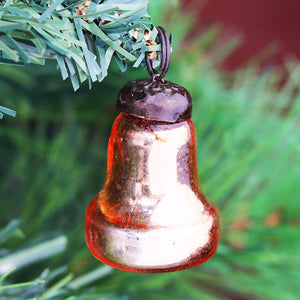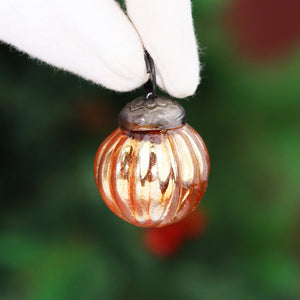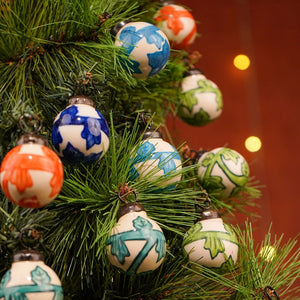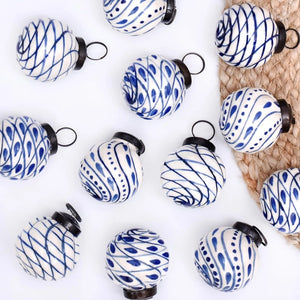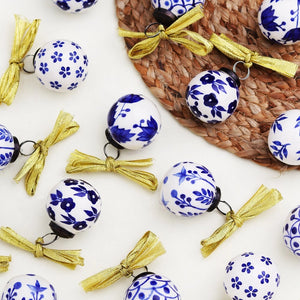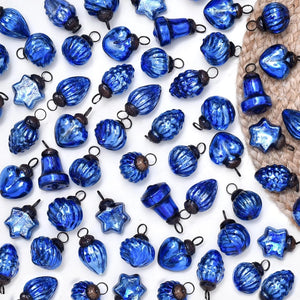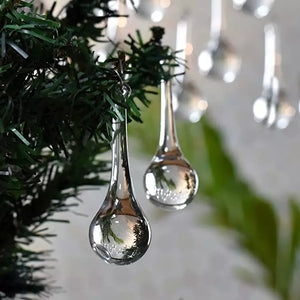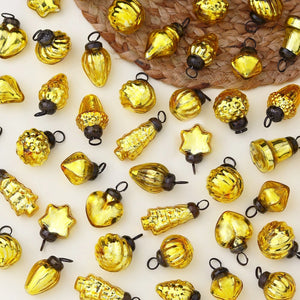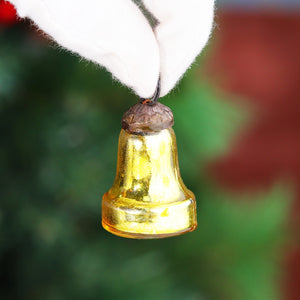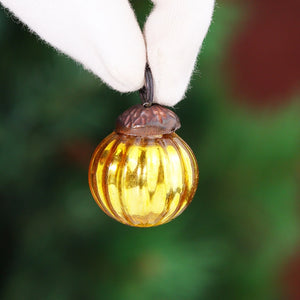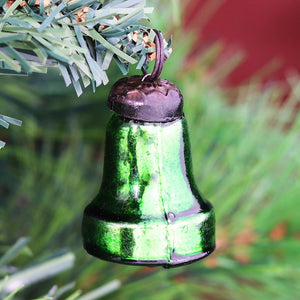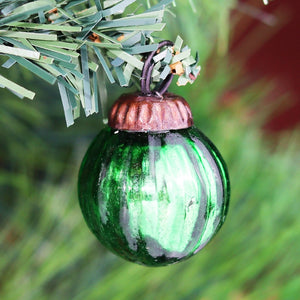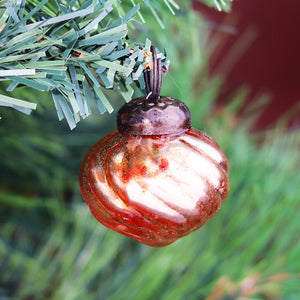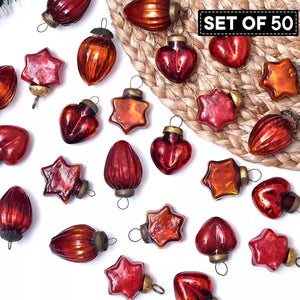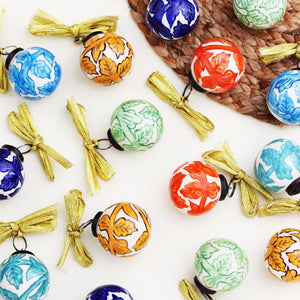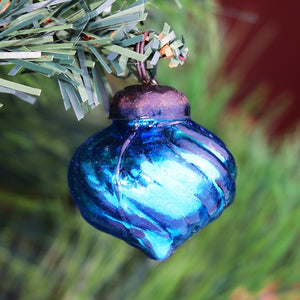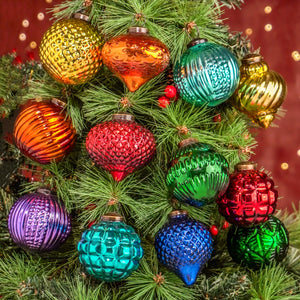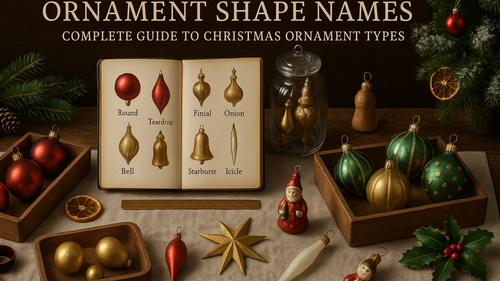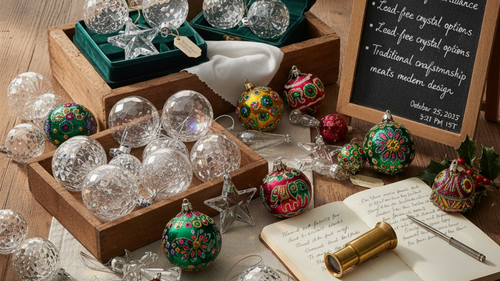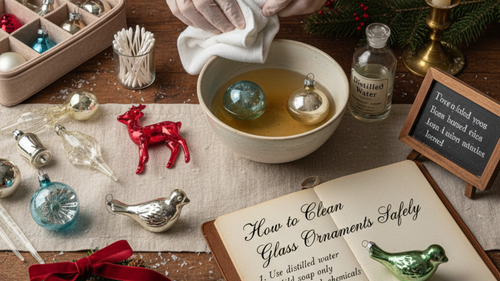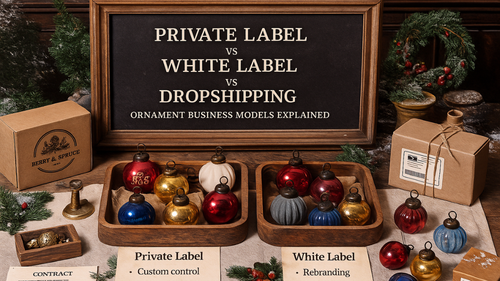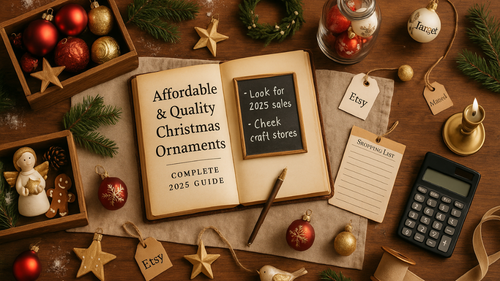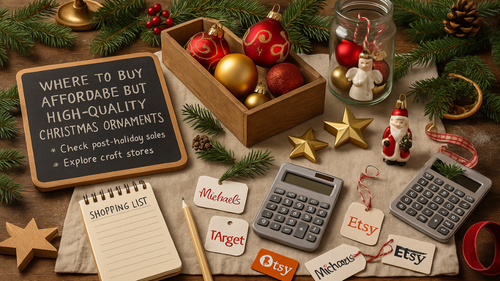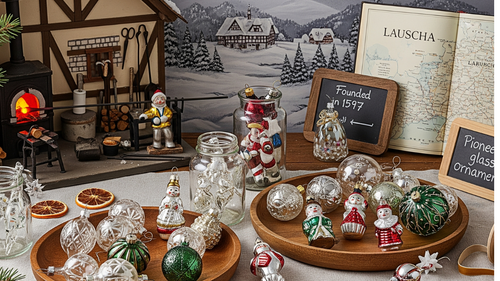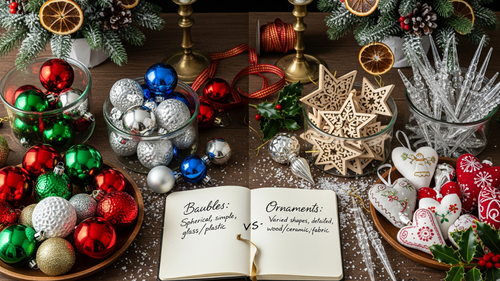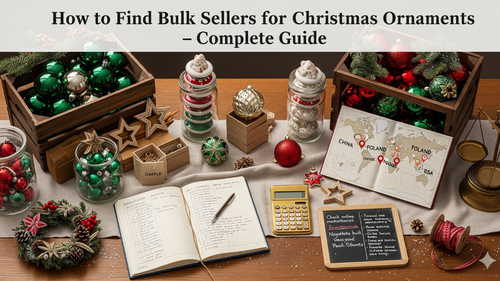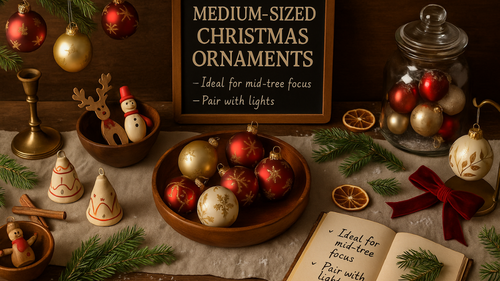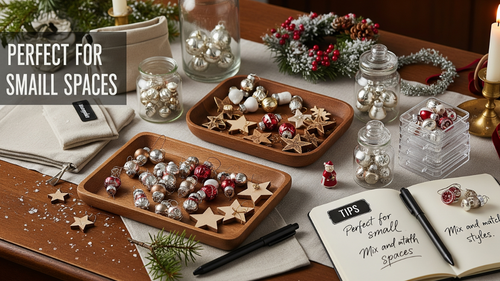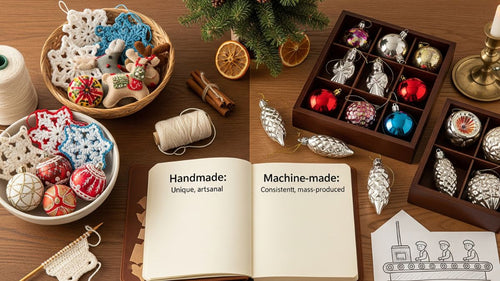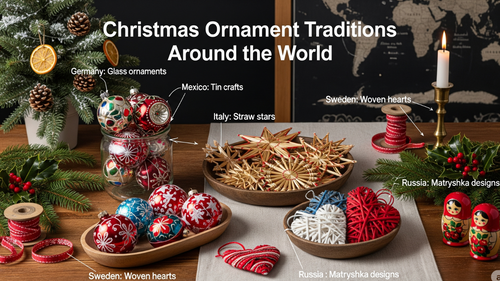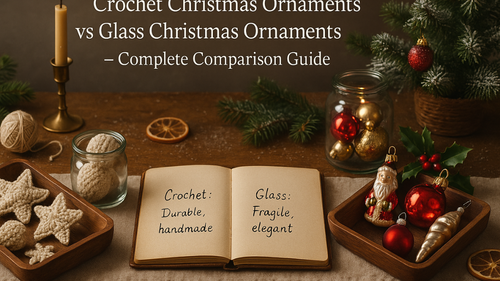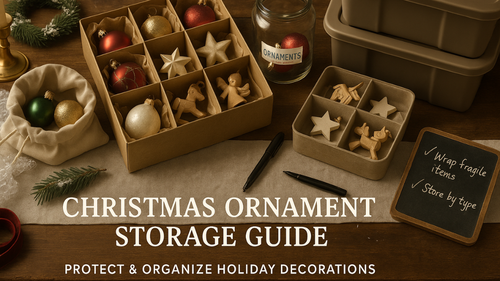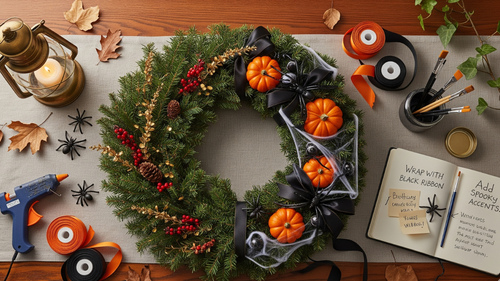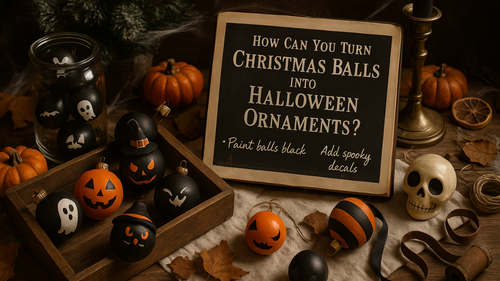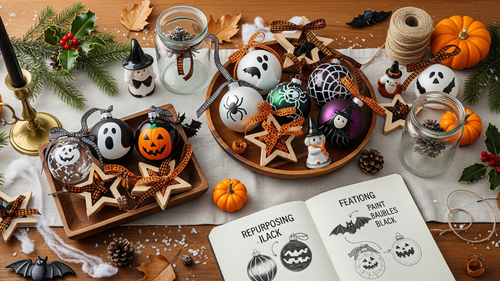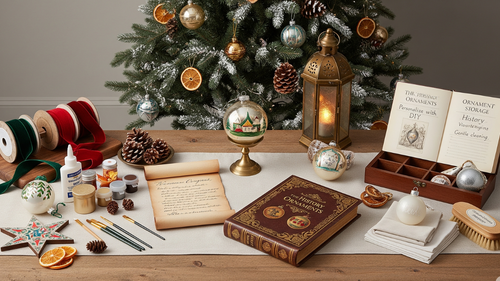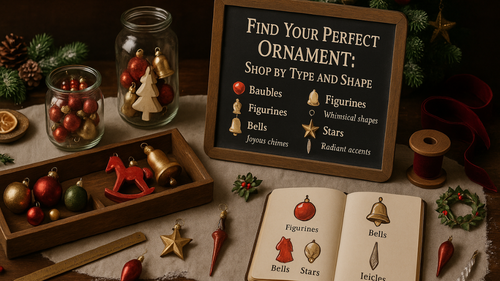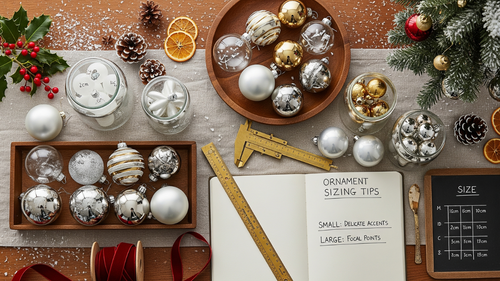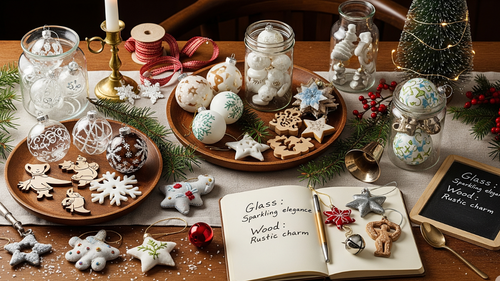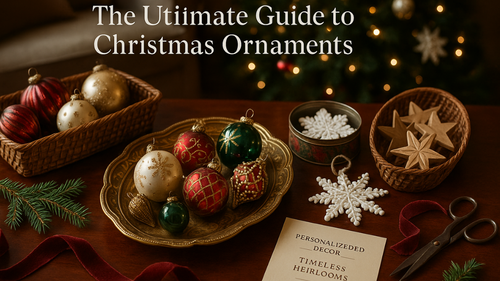Handblown Christmas ornaments—also known as mouth-blown glass ornaments or artisanal glass baubles—are hollow glass decorations shaped by a glassblower's breath and tools, rather than machines. Each piece is unique, lighter than plastic, and—if stored correctly—lasts decades as a collectible.
These delicate treasures represent the pinnacle of holiday decoration craftsmanship, combining centuries-old glassblowing techniques with modern artistry that transforms ordinary Christmas trees into luminous displays of hand-crafted beauty.
Featured Products
Unlike mass-produced plastic alternatives, handblown ornaments are individually crafted by skilled artisans who shape molten glass using breath, specialized tools, and years of expertise. Each piece weighs approximately 5-10 grams compared to 15-20 grams for plastic ornaments, reducing branch strain while maximizing visual impact through their unique translucency and light-catching properties.
The artform traces its roots to 1847 when Hans Greiner revolutionized ornament production in Lauscha, Germany, establishing techniques still practiced today in renowned glassmaking centers worldwide. Modern collectors prize these handcrafted pieces for their individuality, durability spanning 50+ years, and investment potential that can reach thousands of dollars for vintage collections.
This comprehensive guide explores every aspect of handblown Christmas ornaments, from manufacturing processes and care techniques to purchasing decisions and collector markets. Whether you're discovering these artistic treasures for the first time or expanding an existing collection, understanding their unique characteristics helps you make informed choices for your holiday traditions.
Featured Products
Key Takeaways
- Authentic Craftsmanship: Handblown ornaments require 1200°C furnaces and years of artisan training, making each piece unique
- Superior Quality: Weighing 5-10 grams versus 15-20 grams for plastic, they reduce tree branch stress while providing exceptional translucency
- Longevity Investment: Properly maintained handblown ornaments last 50-100+ years, often becoming family heirlooms passed through generations
- Collector Value: Vintage Lauscha ornaments from the 1950s command $200+ each, with rare collections insured for $5,000-$25,000
- Global Heritage: Major production centers include Lauscha Germany, Murano Italy, with distinct regional styles and techniques
What Exactly Are Handblown Christmas Ornaments?
Handblown ornaments (also called mouth-blown glass ornaments and artisanal baubles) are individually crafted glass decorations created using traditional mouth-blowing techniques perfected over centuries. Artisans gather molten soda-lime glass on hollow blowpipes, then use controlled breath pressure and specialized tools to shape each ornament by hand.
The fundamental difference between handblown and machine-made ornaments lies in the manufacturing process. While machines stamp identical pieces from molds, handblown ornaments emerge as unique creations with subtle variations in shape, thickness, and character that make each piece one-of-a-kind.
These artisanal pieces are mouth-blown ornaments, heritage baubles, or artisanal glass ornaments. The terminology reflects their production method, where human breath literally shapes the molten glass, creating the hollow interior that gives handblown ornaments their distinctive lightweight feel and superior light transmission.
Featured Products
Modern handblown ornaments continue traditions established in Lauscha, Germany, where Hans Greiner's 1847 innovations transformed Christmas decoration manufacturing. Today's artisans blend historical techniques with contemporary designs, creating pieces that honor traditional craftsmanship while meeting modern aesthetic preferences.
How Are Handblown Ornaments Made?
Handblown ornaments (mouth-blown glass ornaments, artisanal baubles) require exceptional skill, specialized equipment, and precise temperature control. Master artisans begin by heating soda-lime glass in furnaces reaching 1200°C (2192°F), creating molten glass ready for shaping.
The five-stage creation process involves:
Featured Products
Gathering and Initial Shaping
Artisans collect molten glass on hollow blowpipes, creating a "gather" of workable material. The glass temperature must remain within precise ranges to maintain malleability while preventing thermal shock that could crack the developing ornament.
Blowing and Forming
Controlled breath pressure inflates the molten glass into basic spherical shapes. Experienced glassblowers instinctively regulate air pressure, ensuring consistent wall thickness throughout each piece. This stage requires years of training to master proper breathing techniques and timing.
Shaping and Detailing
Using specialized tools, including punty rods, paddles, and shaping blocks, artisans refine ornament shapes while maintaining the typical wall thickness of 0.6-1.0 mm, depending on studio techniques. Some pieces receive free-form treatment for organic appearances, while others are shaped in traditional molds to create classic geometric forms, such as glass ornament balls and finials.
Annealing Process
Completed ornaments undergo controlled cooling in annealing ovens, gradually reducing temperature over 12-24 hours. This critical step relieves internal stress that could cause spontaneous cracking, ensuring decades of durability.
Finishing and Decoration
Cooled ornaments receive caps, hangers, and decorative treatments. Artisans apply silvering solutions for reflective interiors, hand-paint intricate designs, or add metallic foils and enamel details that distinguish handblown pieces from mass-produced alternatives.
The entire process requires 2-4 hours per ornament depending on complexity, explaining why authentic handblown pieces command premium prices compared to machine-manufactured alternatives.
What Materials and Styles Are Available?
Handblown ornaments (mouth-blown glass ornaments, artisanal baubles) utilize premium materials selected for durability, workability, and aesthetic appeal. Understanding these materials helps collectors and decorators make informed purchasing decisions.
Primary Materials
Soda-lime Glass: The foundation material for most handblown ornaments, chosen for its optimal melting temperature, clarity, and compatibility with decorative treatments. This glass composition provides the perfect balance of workability during creation and durability in finished pieces.
Silvering Solutions: Interior coatings that create the reflective quality distinguishing quality ornaments. Traditional silver nitrate solutions produce the most brilliant reflectivity, though modern alternatives offer similar effects with improved longevity.
Metallic Foils and Leafing: Applied to ornament exteriors for luxurious finishes. Gold leaf, silver leaf, and copper applications create stunning visual effects that catch and reflect tree lighting beautifully.
Ceramic Enamels: Heat-fused paints that create permanent, fade-resistant decorative elements. These materials withstand decades of handling and storage without color degradation.
Popular Styles and Shapes
Traditional ornament shapes include classic balls ranging from 2-6 inches diameter, elegant finials with pointed tops, and delicate icicle forms that add vertical visual interest to tree displays.
Figural ornaments represent advanced artisan skills, featuring detailed animals, Santa figures, angels, and seasonal symbols. These pieces often incorporate multiple glass colors and intricate painting techniques that showcase individual artisan signatures.
Murano millefiori ornaments, crafted by Italian artisans, incorporate complex glass cane techniques that embed colorful, flower-like patterns within clear glass matrices. These pieces represent the pinnacle of decorative glassmaking artistry.
Regional specialties include German Kugeln with their distinctive metallic finishes, Polish spider ornaments adorned with delicate wire decorations, and American studio glass pieces that feature contemporary artistic interpretations of traditional forms.
How Do You Care for Handblown Ornaments?
Hand-blown ornaments (mouth-blown glass ornaments and artisanal baubles) require specific care to ensure they remain beautiful family heirlooms for 50- 100+ years. While surprisingly durable and able to survive low-height knocks up to 30cm, these delicate treasures require different handling, cleaning, and storage techniques than plastic or metal alternatives.
Safe Handling Techniques
Never lift handblown ornaments by their metal caps, which can separate from the glass under stress. Instead, always support the glass body with your palm while using fingers to guide placement. This technique distributes weight evenly and prevents stress concentrations that could cause cracking.
When decorating trees, hang ornaments on interior branches where they're protected from accidental contact. Position delicate pieces away from high-traffic areas and ensure adequate spacing to prevent collisions during air circulation.
Cleaning and Maintenance
Clean hand-blown ornaments using soft-bristle brushes and mild soap solutions. Avoid abrasive cleaners, rough cloths, or aggressive scrubbing that could scratch silvered interiors or painted surfaces. Rinse thoroughly with distilled water to prevent mineral deposits, then air dry completely before storage.
For stubborn residues, use cotton swabs dampened with diluted white vinegar, working gently around decorative elements. Never submerge ornaments with loose caps or damaged areas that might allow water penetration.
Professional Storage Solutions
Store handblown ornaments in acid-free tissue paper within rigid containers featuring individual compartments. Avoid direct contact between pieces and ensure each ornament is completely surrounded by protective padding.
Climate control prevents thermal expansion and contraction that could stress glass. Maintain storage areas at a temperature between 60-70°F with a relative humidity of 40-50%. Extreme temperature fluctuations or high humidity can damage silvering and promote the growth of mold on organic materials.
For comprehensive storage guidance, reference detailed ornament storage techniques that protect investments while maintaining accessibility for seasonal use.
Repair Considerations
Professional restoration services can address minor chips, separated caps, and faded decorations on valuable pieces. However, attempted DIY repairs often cause irreversible damage, destroying both the aesthetic appeal and collector value.
Insurance documentation should include detailed photographs and professional appraisals for collections exceeding $1,000 in value, particularly for vintage Lauscha or Murano pieces that continue to appreciate annually.
Where Should You Buy Handblown Ornaments?
Handblown ornaments (mouth-blown glass ornaments, artisanal baubles) require purchasing from reputable sources with knowledge of authentication techniques and fair market pricing. The 2024-2025 market is expected to show continued growth in both new artisan pieces and vintage collectibles, with typical price ranges observed in specialist dealer listings.
Ordering Calendar Strategy
When to order: Custom logos & colors (July-September for best availability). Best selection of ready-made pieces (September-October). In November and December, choose in-stock pieces only—popular finishes and rare shapes sell out quickly, often requiring rush fees for any remaining custom work.
Trusted Purchase Sources
Artisan Studios and Workshops: Direct purchases from glassblowing studios guarantee authenticity while supporting individual artists. Lauscha, Germany and Murano, Italy remain premier destinations for serious collectors seeking authentic pieces from traditional production centers.
Christmas Markets and Craft Fairs: Seasonal markets often feature regional artisans selling handblown pieces at competitive prices. These venues offer hands-on examination and direct interaction with the artists, providing valuable opportunities for authentication.
Specialized Online Retailers: Established retailers like ChristmasOrnamentsOnline.com offer exceptional value with handblown, artisan-made ornaments starting from just $0.25 USD, making authentic pieces accessible to all budgets. These retailers specializing in ornaments by material provide curated selections with authenticity guarantees and return policies protecting buyers from counterfeit products.
Antique Dealers and Estate Sales: Vintage handblown ornaments frequently appear at estate sales, antique shops, and specialized collector events. These sources offer opportunities to acquire rare pieces, though authentication expertise becomes crucial.
Authentication Guidelines
Authentic handblown ornaments display distinctive characteristics that distinguish them from machine-made alternatives. Look for pontil marks where the punty rod attached during creation - these small rough spots indicate genuine handwork.
Examine the variations in glass thickness throughout each piece. Handblown ornaments exhibit subtle irregularities that reflect human craftsmanship, whereas machine-made pieces maintain a uniform wall thickness throughout.
Weight comparison provides another authentication method. Genuine handblown ornaments typically weigh 5-10 grams, significantly lighter than plastic alternatives, which weigh 15-20 grams.
2025 Pricing Structure
Current pricing for handblown ornaments varies by craftsmanship, materials, and origin. Bulk glass or shatterproof pieces can start around $0.25, while genuine mouth-blown artisan ornaments typically range from $15–$200+ per piece, with Murano and vintage Lauscha examples commanding higher prices.
Budget-Friendly Handblown: $0.25-$15 each for authentic artisan-made pieces from value-focused retailers, making genuine craftsmanship accessible to families on any budget.
Entry-level Artisan Pieces: $15-$40 each for basic handblown balls and simple shapes from contemporary studios. These pieces offer authentic craftsmanship at accessible price points for new collectors.
Premium Contemporary Works: $50-$120 each for complex figural pieces, detailed painting, and recognized artisan signatures. These ornaments represent current artistic excellence and investment potential.
Murano Studio Pieces: $80-$200+ each, featuring authentic Italian glasswork that combines traditional techniques with contemporary interpretations. Murano pieces command premium prices due to regional reputation and artistic heritage.
Vintage Lauscha Collectibles: $200-$500+ each for authenticated 1950s-1960s pieces in excellent condition. Rare shapes, original packaging, and documented provenance significantly increase values.
Corporate and custom orders require 3-6 month lead times, with ordering typically beginning in July-September for December delivery. Custom pieces featuring company logos or personalized elements start at $75-$150 per ornament, depending on complexity.
Why Are Handblown Ornaments Valuable Collectibles?
Handblown ornaments (mouth-blown glass ornaments, artisanal baubles) represent one of the most stable and appreciating collectible markets within decorative arts. Serious collectors build portfolios worth thousands while enjoying seasonal display opportunities that distinguish this category from other investments.
Market Dynamics and Values
Vintage Lauscha ornaments from the 1950s-1960s consistently appreciate 8-12% annually, with exceptional pieces showing even stronger performance. Complete sets in original packaging command significant premiums, often reaching $2,000-$5,000 for rare configurations.
Contemporary artisan pieces also build value, particularly works from recognized studios and individual artists with growing reputations. Limited edition releases and pieces featured in museum exhibitions show strongest appreciation potential.
Insurance companies now regularly cover ornament collections exceeding $5,000, with comprehensive policies available for collections valued at $25,000+. Professional appraisals update every 3-5 years to reflect market appreciation and condition changes.
Popular Collecting Themes
Historical Periods: Collectors focus on specific eras, with pre-WWII German pieces commanding highest prices due to rarity and historical significance. Post-war Shiny Brite collaborations with European artisans represent accessible entry points into vintage collecting.
Regional Specialties: Geographic collecting emphasizes distinct production centers, allowing collectors to explore cultural differences in ornament traditions and techniques.
Figural Categories: Angel ornaments, Santa figures, and animal shapes attract themed collectors who appreciate artistic interpretations across different periods and regions.
Collector Communities and Resources
Active Facebook groups and online forums provide authentication assistance, market pricing guidance, and trading opportunities. Annual collector conventions in major cities feature vendor displays, expert presentations, and networking opportunities.
Specialty publications and online databases document maker marks, production periods, and rarity rankings that guide serious collecting decisions. These resources become invaluable for authentication and valuation purposes.
How Do Handblown Ornaments Compare to Other Types?
Handblown ornaments offer distinct advantages and considerations compared to other ornament materials. Understanding these differences helps consumers make informed decisions based on priorities including durability, aesthetics, budget, and intended use.
| Feature | Handblown Glass (Mouth-blown) | Shatterproof Plastic | Ceramic | Metal |
|---|---|---|---|---|
| Look | Luminous, unique, artisanal | Uniform, safe | Painted/glazed, artisanal | Rustic/modern, reflective |
| Weight (typical) | ~5–10g | ~15–20g | ~20–30g | ~20–40g |
| Durability | Fragile; heirloom-grade | Very durable | Medium | Very durable |
| Lifespan (with care) | 50–100+ years | 5–10 years | 20–50 years | 30–80 years |
| Price Range | $15–$200+ | $0.25–$5 | $5–$50 | $5–$30 |
| Collectibility | High | Low | Medium | Low–Medium |
| Sustainability | Recyclable glass | Disposal challenging | Durable, heavy | Recyclable metal |
Handblown Glass vs. Plastic Ornaments
Handblown glass ornaments excel in visual appeal, offering superior translucency and light refraction that creates stunning tree displays. Their 5-10 gram weight reduces branch stress compared to 15-20 gram plastic alternatives, allowing more ornaments per branch without structural damage.
Plastic ornaments provide unmatched durability for households with young children or pets, essentially eliminating breakage concerns. However, their 5-10 year typical lifespan pales compared to handblown pieces lasting 50-100+ years with proper care.
Cost considerations show plastic ornaments ranging $0.25-$5 each versus $15-$200+ for handblown pieces. Long-term value analysis often favors handblown ornaments due to their heirloom potential and appreciation possibilities.
Handblown Glass vs. Ceramic Options
Ceramic ornaments offer middle-ground solutions combining artistic appeal with moderate durability. Their 20-30 gram weight exceeds both glass and plastic alternatives, potentially stressing delicate branches on smaller trees.
Ceramic pieces typically cost $5-$50 each with 20-50 year lifespans, positioning them between plastic and glass options in both investment and longevity categories.
Handblown Glass vs. Metal Ornaments
Metal ornaments provide maximum durability with 30-80 year lifespans and minimal breakage risk. Their 20-40 gram weight can strain branches, though their rustic aesthetic appeals to contemporary decorating preferences.
Metal pieces range $5-$30 each, offering moderate investment requirements with strong durability characteristics. However, they lack the luminous quality that makes handblown glass so visually compelling.
Environmental Considerations
Handblown glass ornaments offer excellent recyclability through glass processing systems, though their energy-intensive production creates significant environmental impact during manufacturing.
Plastic ornaments pose disposal challenges due to mixed material construction, while metal ornaments provide straightforward recycling opportunities with minimal processing requirements.
Long-term environmental impact often favors handblown glass due to their multi-generational lifespan reducing replacement frequency compared to shorter-lived alternatives.
How Can You Best Display Handblown Ornaments?
Handblown ornaments (mouth-blown glass ornaments, artisanal baubles) require thoughtful display strategies that maximize their unique characteristics while ensuring protection from damage. Showcasing these pieces effectively involves understanding their translucent properties and designing displays that highlight their individual craftsmanship.
Tree Decorating Strategies
Create visual depth by layering handblown ornaments at varying distances from tree trunks. Position larger pieces deeper within branches while placing smaller, more detailed ornaments toward branch tips where lighting illuminates intricate features.
Balance ornament sizes throughout the tree rather than clustering similar pieces. Mix medium-sized ornaments with smaller accent pieces to create dynamic visual flow that draws attention throughout the entire display.
Utilize the translucent properties of handblown glass by positioning pieces where tree lighting creates internal illumination. LED lights work particularly well with glass ornaments, providing consistent illumination without excessive heat that could cause thermal stress.
Alternative Display Options
Glass display domes protect valuable pieces while allowing year-round enjoyment. These enclosed displays prevent dust accumulation and accidental damage while showcasing ornament details impossible to appreciate on crowded trees.
Rotating display stands create dynamic presentations perfect for showcasing individual masterpieces or small collections. These mechanisms allow appreciation of ornament details from all angles while creating engaging focal points.
Shadow boxes and wall-mounted display cases transform ornament collections into permanent home décor elements extending their visual impact beyond traditional holiday seasons.
Garland and Wreath Integration
Incorporate lightweight handblown pieces into garland arrangements for doorways, mantels, and stair railings. Choose smaller ornaments that complement garland proportions without overwhelming the overall composition.
Wreath applications require careful weight distribution to prevent lopsided appearances. Position handblown ornaments strategically around wreath circumferences, balancing visual weight with structural considerations.
Corporate and Event Applications
Custom handblown ornaments featuring corporate logos create memorable gifts for high-value clients and important business relationships. These pieces often become permanent office decorations, providing year-round brand visibility.
Wedding and anniversary ornaments commemorate special occasions while creating lasting keepsakes guests treasure for decades. Personalized pieces with dates, names, or special messages become family heirlooms marking significant life events.
What Cultural Significance Do They Hold?
Handblown ornaments carry profound cultural meanings rooted in religious symbolism, folk traditions, and family heritage spanning multiple generations and geographic regions.
Religious and Spiritual Symbolism
Traditional ornament shapes carry specific religious meanings that enhance their decorative function. Star ornaments represent divine guidance and the Star of Bethlehem, while angel figures symbolize heavenly messengers and spiritual protection.
Heart-shaped ornaments embody divine love and human compassion central to Christmas celebrations. Bell ornaments traditionally announce joyful news and call communities to worship, while cross-shaped pieces directly reference Christian faith foundations.
Cultural and Regional Traditions
German Kugeln (balls) originally symbolized abundance and prosperity for the coming year. These silvered spheres reflected candlelight in pre-electric eras, creating magical illumination that transformed humble homes into wonderlands.
Polish figural ornaments often feature intricate wire work and detailed painting representing folk art traditions passed through generations. These pieces preserve cultural identity while celebrating shared Christmas heritage.
Italian Murano ornaments showcase glassmaking excellence dating to medieval times, combining Christmas traditions with artistic mastery that defines regional cultural identity.
Family Heirloom Traditions
Handblown ornaments frequently serve as family chronology markers, with new pieces commemorating births, marriages, graduations, and other significant milestones. These collections become visual family histories told through beautiful objects.
Inheritance traditions surrounding ornament collections create strong emotional connections spanning generations. Grandchildren often receive specific pieces carrying family stories and memories that connect them to deceased relatives and family heritage.
Annual ornament gift exchanges establish family traditions where each member contributes new pieces to collective displays, building shared memories while expanding treasured collections.
Frequently Asked Questions
Are all handblown ornaments completely hollow inside?
Yes, authentic handblown ornaments are hollow throughout their interior space. This hollow construction results from the blowing process that inflates molten glass using controlled air pressure. The hollow interior also contributes to their lightweight character and superior light transmission properties.
How fragile are handblown ornaments compared to plastic alternatives?
Handblown glass ornaments require careful handling but aren't as fragile as many people assume. Quality pieces withstand normal use for 50-100+ years when handled properly. The main vulnerability involves impact damage from drops or collisions, while plastic ornaments resist breakage but typically last only 5-10 years before showing wear.
How can I identify genuine handblown ornaments versus machine-made copies?
Look for pontil marks where artisan tools attached during creation, slight weight variations between similar pieces, and subtle thickness differences throughout the glass. Genuine handblown pieces show individual character variations, while machine-made ornaments display uniform consistency. Weight testing also helps - authentic pieces typically weigh 5-10 grams versus 15-20 grams for plastic alternatives.
Can handblown ornaments be personalized or customized?
Yes, many artisan studios offer customization services including hand-painted names, dates, or special messages. Etched designs, corporate logos, and custom color combinations are also available. However, customization requires 3-6 month lead times and typically costs $75-$150+ per piece depending on complexity.
When should I place orders for Christmas delivery?
Order handblown ornaments between July and September for guaranteed Christmas delivery. Popular pieces and custom orders often sell out by October, particularly vintage reproductions and limited edition releases. Early ordering also provides better selection and potential early-bird pricing discounts.
Do handblown ornaments require special tree considerations?
Their lightweight construction (5-10 grams) actually reduces branch stress compared to heavier alternatives. However, position them on interior branches protected from accidental contact, and ensure adequate spacing to prevent collision damage. LED lighting works best as it generates minimal heat that could cause thermal stress.
Are handblown ornaments safe for households with children or pets?
Handblown ornaments require supervision around young children and curious pets due to breakage potential. Consider displaying valuable pieces in protected areas while using durable alternatives on lower tree sections accessible to children and pets.
How do I store handblown ornaments safely between seasons?
Use acid-free tissue paper and rigid storage containers with individual compartments. Maintain stable temperatures between 60-70°F with 40-50% humidity. Never stack ornaments directly on top of each other, and inspect storage areas regularly for pest activity or environmental changes that could damage stored pieces.
What's the difference between Lauscha and Murano handblown ornaments?
Lauscha ornaments from Germany emphasize traditional Christmas themes with excellent silvering and classic shapes. Murano pieces from Italy showcase advanced artistic techniques including millefiori patterns and complex color work. Both regions produce exceptional quality, but Murano pieces often command higher prices due to artistic complexity.
How do I spot a genuine mouth-blown ornament?
Look for a small pontil mark, slight thickness variations, and a lighter feel (~5–10g). Machine-made pieces are uniformly thick with molded seams.
Which is safer around kids—glass or shatterproof?
Use shatterproof on lower branches and display handblown pieces higher or in cases.
Do handblown ornaments need special storage?
Yes: acid-free tissue, rigid dividers, and stable 60–70°F with 40–50% relative humidity.
When should I buy to avoid sell-outs?
Order by July-September for custom work, September-October for best ready-made selection. November-December means limited in-stock choices only.
Conclusion
Handblown Christmas ornaments represent the perfect fusion of artistic craftsmanship, cultural heritage, and practical beauty, transforming ordinary holiday displays into extraordinary celebrations. These individually crafted treasures offer unique advantages including superior aesthetics, remarkable durability, and investment potential that distinguishes them from mass-produced alternatives.
Understanding their manufacturing processes, authentication characteristics, and proper care techniques empowers consumers to make informed purchasing decisions while protecting valuable investments for future generations. Whether you choose contemporary artisan pieces or pursue vintage collectibles, handblown ornaments offer lasting value that extends far beyond their seasonal use.
The 2025 market continues showing strong growth in both new production and collector segments, making this an opportune time for both first-time buyers and serious collectors to explore available options. From affordable entry-level pieces to museum-quality masterworks, handblown Christmas ornaments offer something for every budget and aesthetic preference.
Their cultural significance, artistic merit, and heirloom potential ensure that handblown Christmas ornaments will continue to enchant families and collectors for generations to come. By choosing these authentic pieces, you're not simply buying decorations - you're investing in handcrafted art that preserves traditional skills while creating lasting memories for your own family traditions.
Start or expand your collection today by exploring the exceptional selection of handblown glass ornaments available through trusted retailers who guarantee authenticity and provide the expertise necessary for making confident purchasing decisions.


